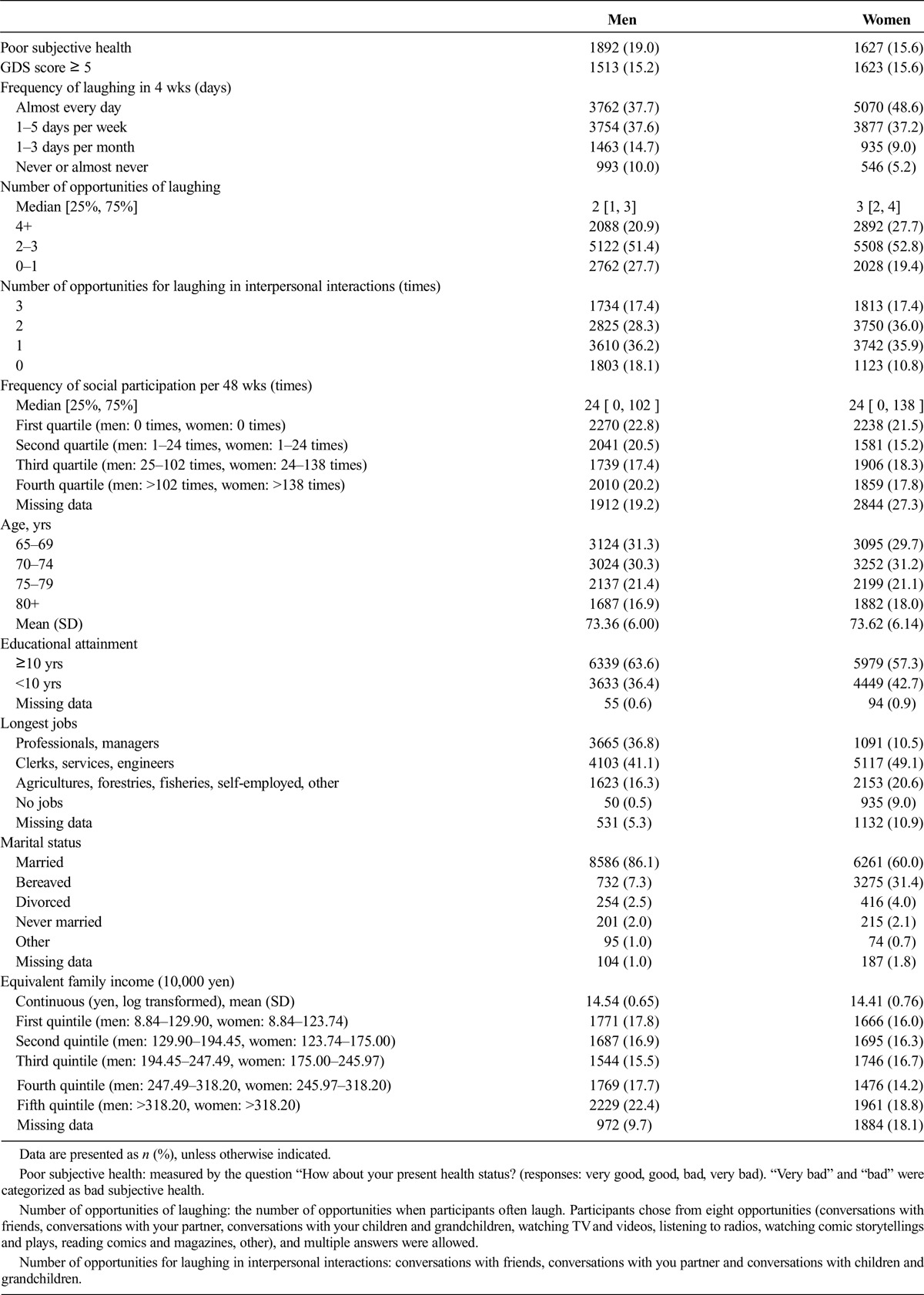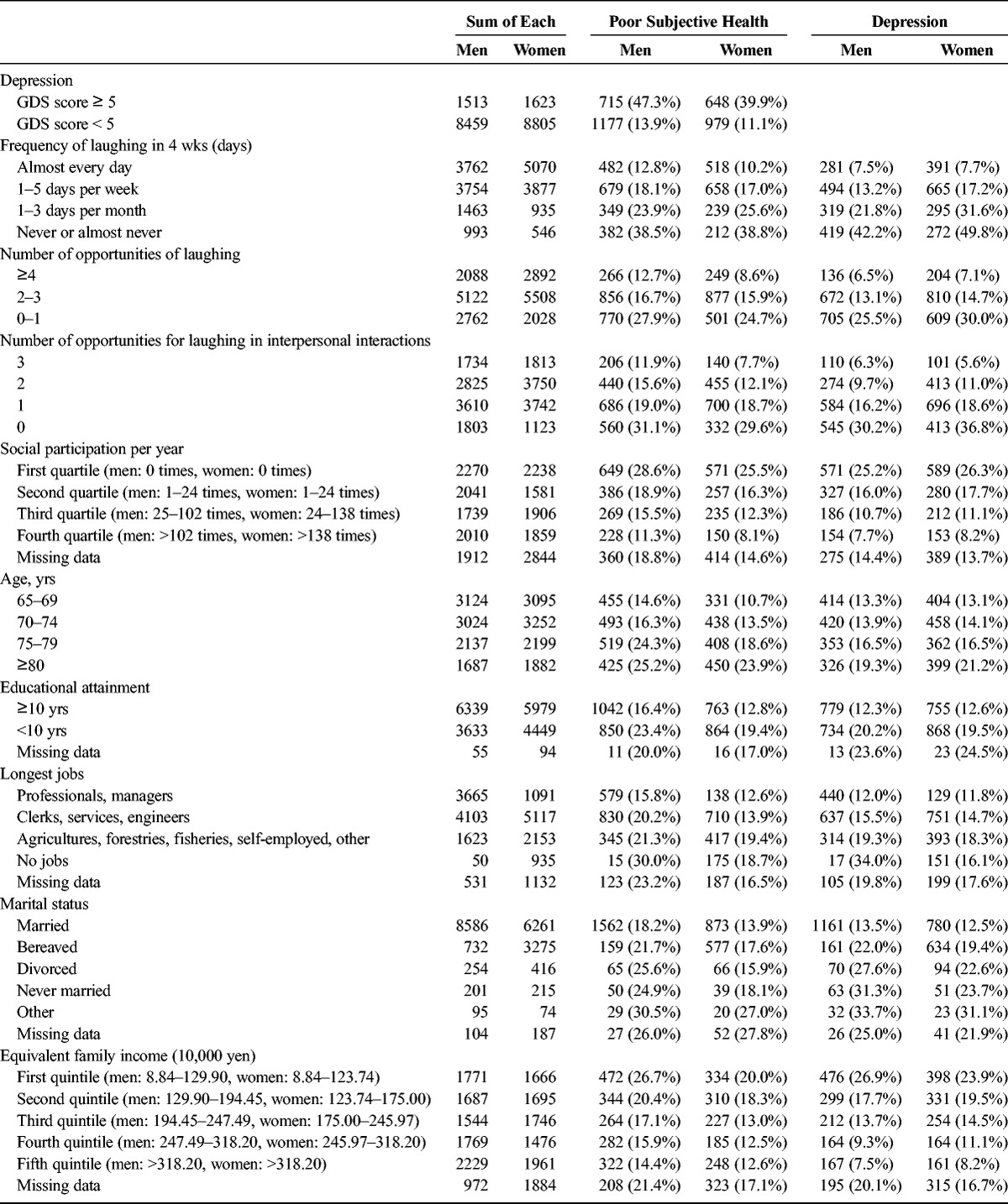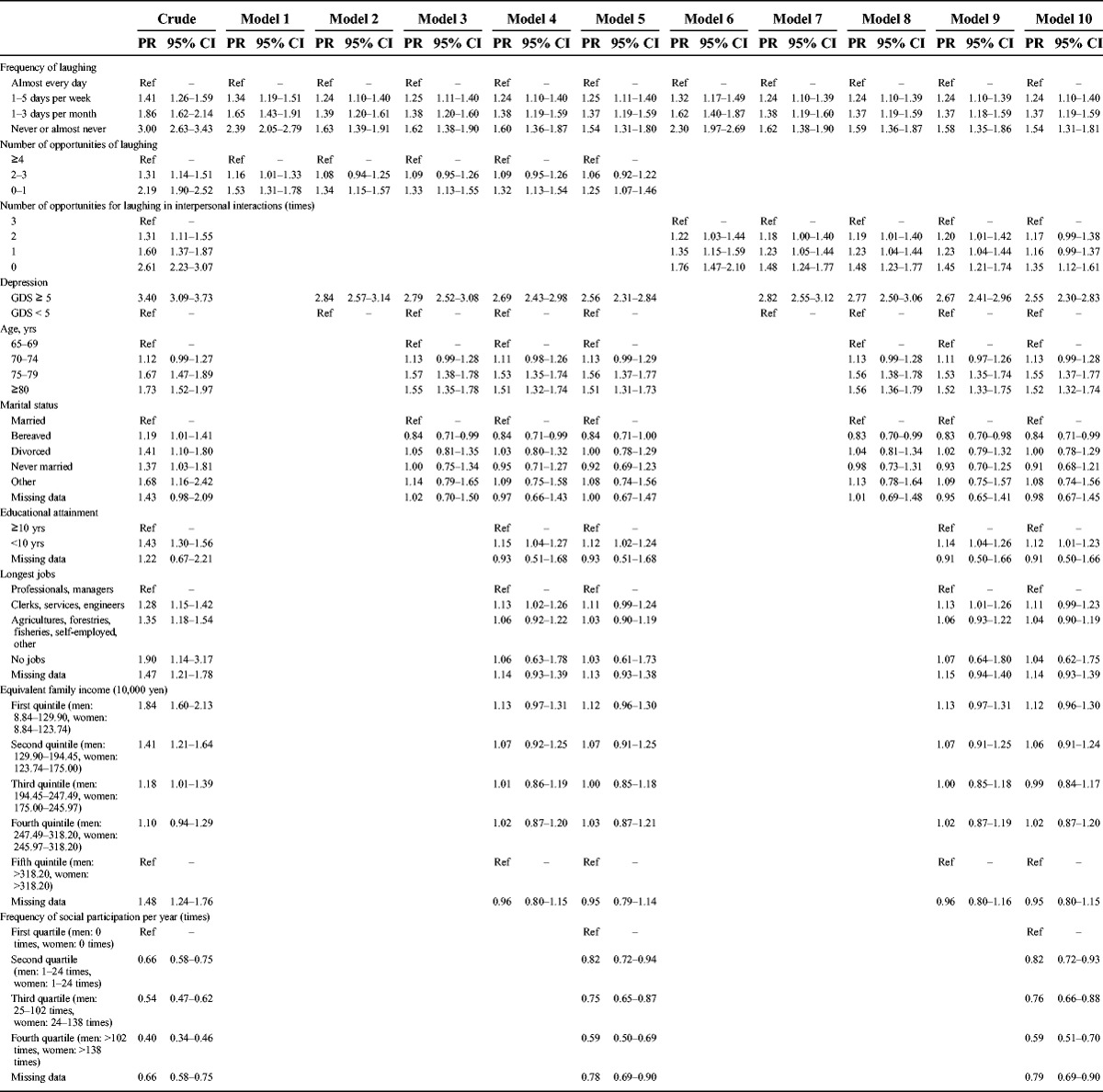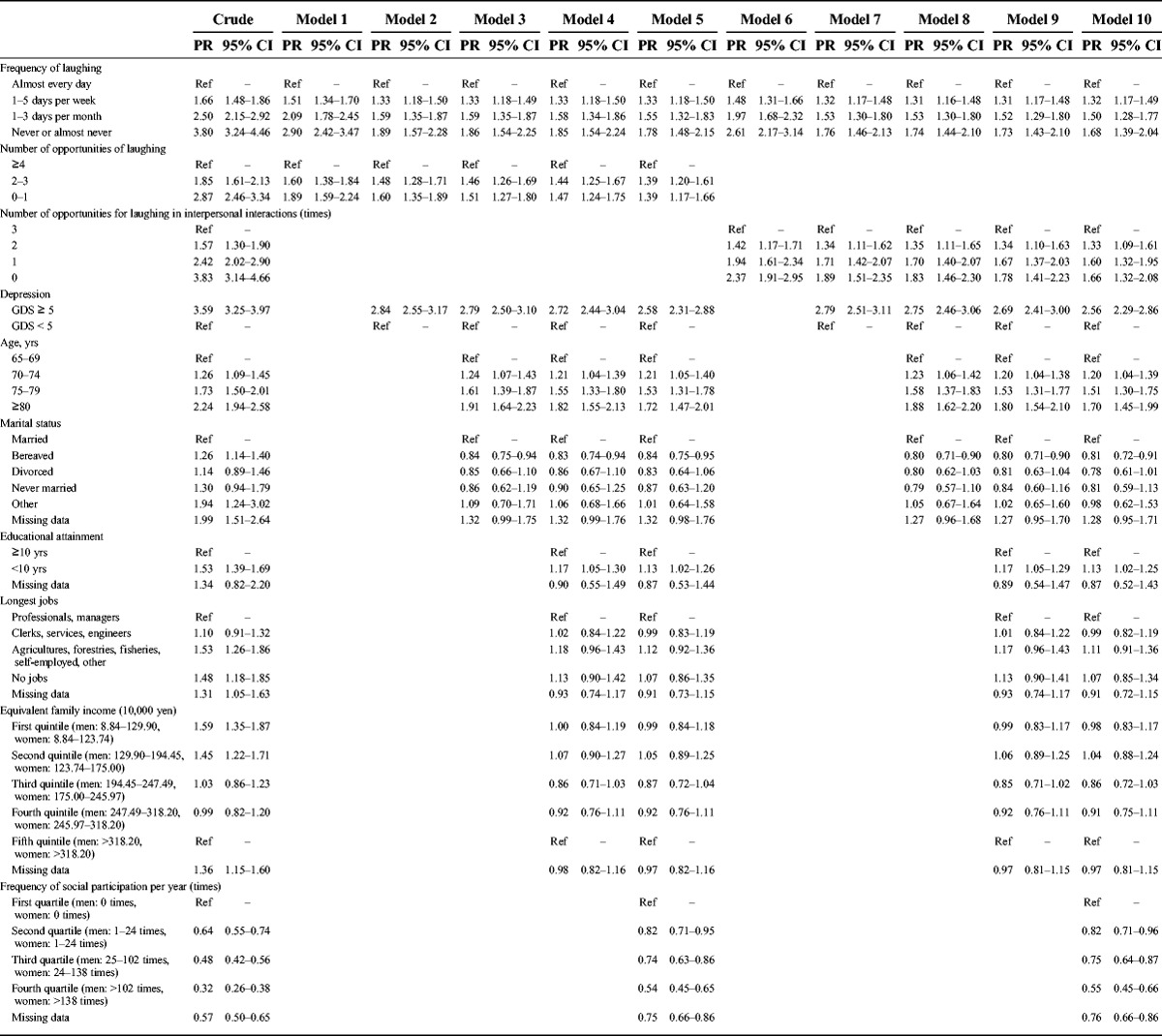Abstract
The aim of this study was to evaluate the association of laughter with subjective health independent of socioeconomic status and social participation among older people in Japan. We used the data of 26,368 individuals (men, 12,174; women, 14,194) 65 years or older who participated in the Japan Gerontological Evaluation Study (JAGES) in 2013. Participants provided information on laughter and self-rated health, depression, socioeconomic, and psychosocial factors. We evaluated laughter from three perspectives: frequency, opportunities, and interpersonal interactions. Even after adjustment for depression, sociodemographic factors, and social participation, the prevalence ratio for poor subjective health among women who never or almost never laugh was 1.78 (95% confidence interval, 1.48–2.15) compared with those who reported laughing every day. Similar associations were observed among men. Laughter may be an important factor for the promotion of general and mental health of older adults. The mechanisms linking laughter and health warrant further study.
Key Words: Laughter, subjective health, depression, social participation, Japan
Previous studies have suggested that laughter has various health benefits, such as boosting immunity (Sakai et al., 2013), reducing depressive symptom (Hirsch et al., 2010), lowering blood pressure (Dolgoff-Kaspar et al., 2012), and preventing cognitive decline (Takeda et al., 2010). Laughter has been incorporated in complimentary medicine. Laughter yoga has been shown to be feasible in the hemodialysis context, and patients reported decreased fatigue, pain relief and improved communication (Bennett et al., 2014). The Smile-Sun technique, a set of positive verbal and nonverbal communication techniques using positive humor, has been applied in cancer patients to boost immunity (Sakai et al., 2013). Laughter also improves glycemic control among diabetes patients (Bennett et al., 2014). However, most of the previous studies did not generalize beyond the boundaries of the hospital and clinic, and very few were able to examine the impact of laughter on health in daily life or in the social context.
Laughter has been found to occur most frequently during casual conversation (Provine, 1993), and laughter usually occurs when one encounters a meaningful interpretation of some stimulus or event that is different from which was initially assumed (Ramachandran, 1998). The frequency of laughter likely varies according to one's character and social background. That is, the frequency and opportunities for laughter can vary according to one's life situation, especially socioeconomic status and degree of social participation, and these factors could confound the effect of laughter on health, but this theory has yet to be examined.
Hasan and Hasan (2009) conducted a study among patients from India and Canada to characterize the frequency of laughter that was beneficial or detrimental to health. Among participants in India, a moderate level of laughter was found to be beneficial, whereas both low and high levels had no effect. Laughter was associated with emotional well-being and life satisfaction. In other words, frequency of laughing and the way of laughter influence health differently from environments.
To our knowledge, no studies have been conducted on the relationship between laughter and health, taking account of people's socioeconomic background and degree of social participation. Socioeconomic status and social participation can be considered common previous causes (i.e., confounders) of the association between laughter and health. We therefore set out to examine the relationship between laughter and subjective health adjusting for socioeconomic factors and social participation, evaluating laughter from three perspectives: frequency, number of opportunities, and laughing in interpersonal interactions.
METHODS
Study Sample
The present study is based on the Japan Gerontological Evaluation Study (JAGES). The JAGES cohort was established in 2010 to investigate factors associated with subjective and objective health among noninstitutionalized individuals 65 years or older. The cohort covers 30 municipalities in Japan. We used the 2013 wave of JAGES, where self-reported questionnaires were mailed to 195,290 community-dwelling individuals 65 years or older. Of those, 138,294 individuals responded to the survey (response rate, 70.8%). Aside from basic questions, there were five modules of the survey covering different topics—module A: nursing care, medical care, and lifestyles; module B: oral hygiene, optimism, subjective health; module C: social capital, history of abuse; module D: subjective quality of life, sleep, cognitive function; module E: physical activity. We used module B, which includes questions about laughter. Respondents to module B were composed of 12,174 men and 14,194 women. We excluded 5968 subjects (men, 2202; women, 3766) with missing information on subjective health status, frequency of laughing, depression (the short form of Geriatric Depression Scale [GDS]), number of opportunities of laughing, sex, or age.
Poor Subjective Health
Our outcome variable was poor self-rated health, assessed by the standard single-item question “How would you rate your present health status? (responses: very good, good, bad, very bad)”; “very bad” and “bad” were categorized as poor subjective health.
Laughter
We analyzed three types of variables related to laughter: frequency of laughing, number of opportunities for laughter, and laughing during interpersonal interactions. Respondents were asked to check up to eight different opportunities for laughing: during conversations with friends, conversations with a partner, conversations with children and grandchildren, watching TV and videos, listening to the radio, watching comic storytellings and plays, reading comics and magazines, and other. Three possible responses were given for laughing during interpersonal interactions: conversations with friends, conversations with a partner, and conversations with children and grandchildren.
Covariates
We controlled for age, sex, marital status, education, occupation, equivalized household income, depressive symptoms, and social participation. For the evaluation of depressive moods, the 15-item GDS (GDS-15) was used. The GDS-15 is a 15-item questionnaire, with a score range from 1 to 15. Higher scores indicate more depressive symptomatology. Following previous studies, we used 5 as the cutoff score for indicating moderate to severe psychological distress (Wongpakaran et al., 2013). For the evaluation of depressive moods, we measured frequency of social participations by summing up the number of opportunities per year one participated in social activities and groups. We divided them into four quartiles and used the first quartile as the reference category.
Statistical Analysis
Poisson regression model was used to calculate the prevalence ratio (PR) for poor subjective health by frequency of laughing. In model 1, we controlled for the number of opportunities for laughter. In model 2, depressive symptoms was added as a potential confounder. In model 3, demographic variables (age, sex, marital status) were added to the variables in model 2. In model 4, socioeconomic variables (education, occupation, and equivalized household income) were added to the variables in model 3. In the final model 5, social participation (frequency of social participation per year) was added to the variables in model 4. In models 6 to 10, we repeated the same sequence of analyses as models 1 to 5, except we switched “number of opportunities for laughter” with “number of opportunities for laughter during interpersonal interactions” as a covariate. R 3.1.0 was used for statistical analysis, with a two-tailed significance level set at 5%.
RESULTS
Baseline characteristics are shown in Table 1. Women tend to laugh more frequently as well as to report a higher number of opportunities for laughter, compared with men. The prevalence of poor subjective health and depression according to participants' characteristics are shown in Table 2. We paid particular attention to statistically controlling for depressive symptoms, given the possibility that absence of laughter could be a symptom of depression.
TABLE 1.
Characteristics of the Subjects by Sex

TABLE 2.
Prevalence of Poor Subjective Health and Depression by Participants' Characteristics

The results of Poisson regression models linking laughter and poor subjective health are shown in Tables 3 and 4. Subjective health was associated with occupation, marital status, and household income in men. For women, in model 1, we found an association between frequency of laughter and poor self-rated health. The PR comparing the bottom to top category of frequency was 3.80 (95% confidence interval [CI], 3.24–4.46). With the successive addition of covariates (across models 2–5, as well as from models 6–10), the PR became more attenuated. Nonetheless, even in the fully adjusted models (models 5 and 10), we found significant associations between frequency of laughter and self-rated health. For women, in model 5, the PRs of poor self-rated health were 1.78 (1.48–2.15) for laughing never or almost never and 1.39 (1.17–1.66) for none to one opportunity of laughing. We found similar tendencies, albeit somewhat weaker associations, among men.
TABLE 3.
PR and CI for Poor Subjective Health in Men

TABLE 4.
PR and CI for Poor Subjective Health in Women

In a subanalysis, we did the same analysis, except we switched subjective health with depression as the objective variable. There were stronger relationships between laughing and depression in both men and women. For women, in model 4, where we controlled all the covariates, the PRs were 3.61 (3.02–4.31).
DISCUSSION
The purpose of the present study was to investigate the effects of laughter on self-rated health after carefully controlling for potential confounders. The results of the study showed that frequency of laughing is significantly related to subjective health. Although some categories of laughter were not significant in men, the results still suggested a protective effect of laughter, both in terms of frequency as well as number of different occasions for laughter. Statistical adjustment for depression, sociodemographic factors, and social participation resulted in an attenuation of the relation. Depression and social participation were especially important confounders to consider. Nonetheless, our findings suggest that encouraging laughter may be a potential avenue for health promotion.
The relationship between laughter and subjective health may be underpinned by at least four distinct mechanisms (Martin, 2002). First, laughter may have direct psycho-neuro-immunological benefits such as lowering markers of inflammation. Second, laughter may be a marker of positive emotions, which can promote resilience against disease (Kubzansky, 2011). Third, laughing can buffer the effects of stress (Berk et al., 1989). Finally, people who laugh often can make a good impression on others and make others more likely to help them, for example, by providing them with social support.
The simple frequency of laughter seems to be more predictive of subjective health than the number of different occasions/contexts for laughter. This finding is consistent with previous studies that have found that laughing frequently is related to emotional well-being and life satisfaction (Hasan and Hasan, 2009). According to Schimmack et al. (2002), life satisfaction is correlated with emotional well-being, and the association is stronger in individualistic societies. The current study shows that there are stronger relationships between laughter and subjective health in older people. Alpass and Neville (2003) reported in their study that the most significant predictor of depression in older men was loneliness and that age-related losses (such as decline in mobility) may weaken their ability to maintain relationships with others. The current study also shows that women laugh more frequently than men do and laughter is more strongly related to subjective health among women. LaFrance et al. (2003) reported that women smile and laugh more than men do. These findings suggest that laughter is especially important for old people and women.
However, the present study had limitations. First and foremost, we are unable to establish a causal relationship between laughter and poor subjective health owing to the cross-sectional nature of the data. Longitudinal analyses of our cohort data will clarify how laughing can prevent poor subjective health. In addition, we cannot completely exclude the possibility of reverse causation, even though the study controlled for depression and other covariates. The third limitation is that all the answers to questionnaire were self-reported. The perceived frequency of laughter may be at variance from the actual frequency, but we lacked objective data on laughing frequency. Moreover, we did not consider the types of laughter. There are many types of laughing, for example, smiling is an indication of fondness and appeasement, whereas laughter expresses playfulness (Hooff, 1972), and Duchenne laughter is coming from positive emotion, whereas non-Duchenne laughter is fake laughter (Gervais and Wilson, 2005). Further studies are needed to examine these differences among various types of laughter. There is missing information for 882 subjects with missing in subjective health status, 1306 in laughter, and 4692 in depression. It may be plausible that less healthy people are more likely not to report their health status, possibly making the association between laughter and health underestimated. Finally, it is unclear whether laughter can prevent disease onset. Although previous research has indicated that laughter can improve the biomarkers of immune function (Bennett and Lengacher, 2009; Donkor et al., 2014), there were very few studies that examined actual disease outcomes. Martin (2002) even reported that many studies regarding the health benefits of humor and laughter are less conclusive than commonly believed. However, Donkor et al. (2014) showed that health-related quality of life among stroke survivors was significantly related to laughter, and this is consistent with our subanalysis. Future study needs to investigate further this point.
In conclusion, laughter may lower the risk of poor subjective health of older people, and this effect was observed even after adjusting for depression, socioeconomic status, and social participation. Moreover, laughing frequently regardless of situations may be effective for decreasing the risk. The mechanisms and determinants of laughter warrant further study to use laughter effectively to improve the physical and psychological health of old people.
ACKNOWLEDGMENTS
This study used data from the JAGES, conducted by the Center for Well-Being and Society, Nihon Fukushi University, as one of their research projects, which was supported by Health Labour Sciences Research Grant, Comprehensive Research on Aging and Health (H26-Choju-Ippan-006, H25-Choju-Ippan-003, H25-Kenki-Wakate-015, H25-Irryo-Shitei-003(Fukkou), H24-Junkanki(Syosyu)-Ippan-007) from the Ministry of Health, Labour, and Welfare, Japan; Grant-in-Aid for Scientific Research (20319338, 22390400, 23243070, 23590786, 23790710, 24140701, 24390469, 24530698, 24653150, 24683018, 25253052, 25870573, and 25870881) from the Japan Society for the Promotion of Science; and a grant from National Center for Geriatrics and Gerontology, Japan (24-17, 24-23, J09KF00804).
DISCLOSURE
The authors declare no conflict of interest.
REFERENCES
- Alpass FM, Neville S. (2003) Loneliness, health and depression in older males. Aging Ment Health. 7: 212– 216. [DOI] [PubMed] [Google Scholar]
- Bennett MP, Lengacher C. (2009) Humor and Laughter May Influence Health IV. Humor and Immune Function. Evid Based Complement Alternat Med. 6: 159– 164. [DOI] [PMC free article] [PubMed] [Google Scholar]
- Bennett PN, Parsons T, Ben-Moshe R, Weinberg M, Neal M, Gilbert K, Rawson H, Ockerby C, Finlay P, Hutchinson A. (2014) Laughter and humor therapy in dialysis. Semin Dial. 27: 488– 493. [DOI] [PubMed] [Google Scholar]
- Berk LS, Tan SA, Fry WF, Napier BJ, Lee JW, Hubbard RW, Lewis JE, Eby WC. (1989) Neuroendocrine and stress hormone changes during mirthful laughter. Am J Med Sci. 298: 390– 396. [DOI] [PubMed] [Google Scholar]
- Dolgoff-Kaspar R, Baldwin A, Johnson MS, Edling N, Sethi GK. (2012) Effect of laughter yoga on mood and heart rate variability in patients awaiting organ transplantation: A pilot study. Altern Ther Health Med. 18: 61– 66. [PubMed] [Google Scholar]
- Donkor ES, Owolabi MO, Bampoh PO, Amoo PK, Aspelund T, Gudnason V. (2014) Profile and health-related quality of life of Ghanaian stroke survivors. Clin Interv Aging. 9: 1701– 1708. [DOI] [PMC free article] [PubMed] [Google Scholar]
- Gervais M, Wilson DS. (2005) The evolution and functions of laughter and humor: A synthetic approach. Q Rev Biol. 80: 395– 430. [DOI] [PubMed] [Google Scholar]
- Hasan H, Hasan TF. (2009) Laugh yourself into a healthier person: A cross cultural analysis of the effects of varying levels of laughter on health. Int J Med Sci. 6: 200– 211. [DOI] [PMC free article] [PubMed] [Google Scholar]
- Hirsch RD, Junglas K, Konradt B, Jonitz MF. (2010) Humor therapy in the depressed elderly: Results of an empirical study. Z Gerontol Geriatr. 43: 42– 52. [DOI] [PubMed] [Google Scholar]
- Hooff J. (1972) A comparative approach to the phylogeny of laughter and smiling. Retrieved February 6, 2015, from http://www.academia.edu/2217566/A_comparative_approach_to_the_phylogeny_of_laughter_and_smiling.
- Kubzansky LD. (2011) Key 2010 publications in behavioral medicine. Cleve Clin J Med. 78 (Suppl 1): S65– S68. [DOI] [PubMed] [Google Scholar]
- LaFrance M, Hecht MA, Paluck EL. (2003) The contingent smile: a meta-analysis of sex differences in smiling. Psychol Bull. 129: 305– 334. [DOI] [PubMed] [Google Scholar]
- Martin RA. (2002) Is laughter the best medicine? Humor, laughter, and physical health. Curr Dir Psychol Sci. 11: 216– 220. [Google Scholar]
- Provine RR. (1993) Laughter punctuates speech: Linguistic, social and gender contexts of laughter. Ethology. 95: 291– 298. [Google Scholar]
- Ramachandran VS. (1998) The neurology and evolution of humor, laughter, and smiling: The false alarm theory. Med Hypotheses. 51: 351– 354. [DOI] [PubMed] [Google Scholar]
- Sakai Y, Takayanagi K, Ohno M, Inose R, Fujiwara H. (2013) A trial of improvement of immunity in cancer patients by laughter therapy. Jpn Hosp. 53– 59. [PubMed] [Google Scholar]
- Schimmack U, Radhakrishnan P, Oishi S, Dzokoto V, Ahadi S. (2002) Culture, personality, and subjective well-being: Integrating process models of life satisfaction. J Pers Soc Psychol. 82: 582– 593. [PubMed] [Google Scholar]
- Takeda M, Hashimoto R, Kudo T, Okochi M, Tagami S, Morihara T, Sadick G, Tanaka T. (2010) Laughter and humor as complementary and alternative medicines for dementia patients. BMC Complement Altern Med. 10: 28. [DOI] [PMC free article] [PubMed] [Google Scholar]
- Wongpakaran N, Wongpakaran T, Van Reekum R. (2013) The use of GDS-15 in detecting MDD: A comparison between residents in a Thai long-term care home and geriatric outpatients. J Clin Med Res. 5: 101– 111. [DOI] [PMC free article] [PubMed] [Google Scholar]


